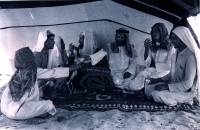
Hospitality in the First Saudi State refers to customs and manifestations of honoring guests in the society of the First Saudi State . These customs encompass good reception, welcoming, and hosting guests, abstaining from asking them for what they need unless three days after hosting them, protecting them and their property, when needed, throughout their stay, and ensuring they are under their host's protection or that of one of the family members wherever the guests go. Hospitality custom...
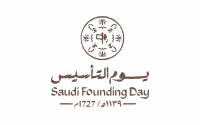
The Saudi Founding Day Logo is the visual identity used to commemorate Founding Day in the Kingdom of Saudi Arabia . It marks the day Imam Mohammed Bin Saud founded the First Saudi State on February 22, 1727. The visual identity was announced on February 4, 2022, under the slogan 'Our Story.' The Saudi Founding Day logo incorporates five historical symbols representing the First Saudi State, alongside text inspired by a historical manuscript. Elements of the Saudi Founding Day logo Th...

Quality of Life in the First Saudi State refers to the set of cultural and civilizational elements that contributed to enhancing the quality of life within the community of the First Saudi State , founded by Imam Mohammed Bin Saud in 1727, lasting till 1818, with Diriyah as its capital. Quality of life elements in the First Saudi State During the era of the First Saudi State, Diriyah reflected the modern definition of quality of life. where it was based on several civilizational and cultural el...
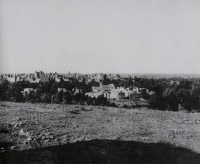
The Political System of the First Saudi State refers to the principles and laws promulgated and applied by the Imams of the First Saudi State , since its establishment, in terms of regulating, managing, and conducting the affairs of the state. The statute is considered the highest administrative regulation of the state as it is used as a basis for the overall regulation of the state. It covered the Imam, the highest authority within the state, the crown prince, the emirate, and the Shura system...
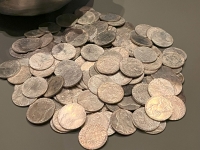
Currency in the First Saudi State refers to the gold, silver, copper, and other metal currencies traded in the First Saudi State (1727-1818). During this era, locally minted currencies and other foreign currencies adopted by politically or economically influential countries in the region surrounding the Arabian Peninsula were traded. Currencies used in the First Saudi State Locally used currencies during the era of the First Saudi State included al-Ahmar , which was a commonly used currency bac...
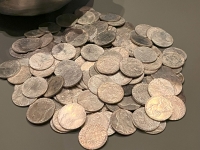
The First Saudi State has disbursed the resources available with Bayt al-Mal (treasury) in favor of various purposes, including: - Amounts settled to those entitled to Zakat, such as the poor and the disadvantaged, each according to their needs and share, pursuant to the provisions of Sharia. - Allocations made in favor of travelers who lost their way or those who did not hold sufficient amounts while traveling, where they would be provided with accommodation, food, and some money to help them ...
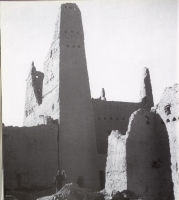
The Financial System of the First Saudi State refers to the financial system applied by the First Saudi State throughout its history, between 1727 and 1818. It is similar to the financial system applied by the Islamic State during the Early Islamic Era. Overseeing the financial system of the First Saudi State The First Saudi State has established a financial system based upon the provisions of Islamic Sharia. Bayt al-Mal (treasury), tasked with overseeing the funds of the state, controlling its...
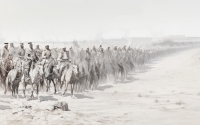
Several governors and army leaders took part in the battles of the First Saudi State during its establishment. They contributed to instilling security and political stability over its ninety-four years of rule, from 1727 to 1818. These governors and army leaders include: Suleiman Bin Afaisan Suleiman Bin Afaisan supported the First Saudi State against its enemies in 1776. He was appointed governor of al-Kharj in 1785. He led several conquests in the eastern Arabian Peninsula. He passed away in ...

Pen-Making in Najd: The people of Najd Region once held an interest in pens, particularly among the educated, whether during al-Katatib (primary education) stage or the subsequent stages. Pens served as tools for writing, both in education and in the creation of Najdi manuscripts, a craft that gained prominence between the fifteenth and nineteenth centuries. One notable example of their dedication was the practice of some scholars lending their pens to others for communal use. These pens were...
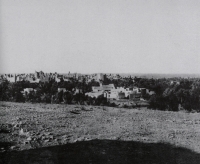
The crown prince in the First Saudi State was appointed according to specific procedures. The Imam would select one of his sons to be a crown prince. He would also be appointed to lead the armies, thus being considered the general commander of the armies. He was also an advisor to him on the state's affairs. However, the first pledge of allegiance was given to Imam Saud Bin Abdulaziz Bin Mohammed Bin Saud, where he was endorsed during the reign of his father Imam Abdulaziz Bin Mohammed in ...
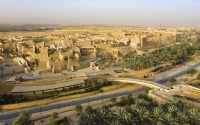
The designation ' Diriyah ' is derived from the fact that Mani' Ibn Rabi'a al-Muraydi, the ancestor of the Saudi family, lived with his relatives in the eastern Arabian Peninsula, settling in a place called Diriyah near the town of al-Qatif. In 1446, he corresponded with a relative named Ibn Dir' who held influence in al-Yamama. As a result of their correspondence, Mani' and his family moved from the eastern Arabian Peninsula to Wadi Hanifah. Upon reaching this val...

The First Saudi State was established in 1727 by Imam Mohammed Bin Saud. During that period, it was ruled by four imams: Imam Mohammed Bin Saud: He assumed leadership of ad-Diriyah Emirate in 1727, and declared the establishment of the First Saudi State. His rule ended in 1765. Imam Abdulaziz Bin Mohammed: He assumed leadership in 1765, and his rule ended in 1803. Imam Saud Bin Abdulaziz: He assumed leadership in 1803, and his rule ended in 1814. Imam Abdullah Bin Saud: He assumed leadership in...